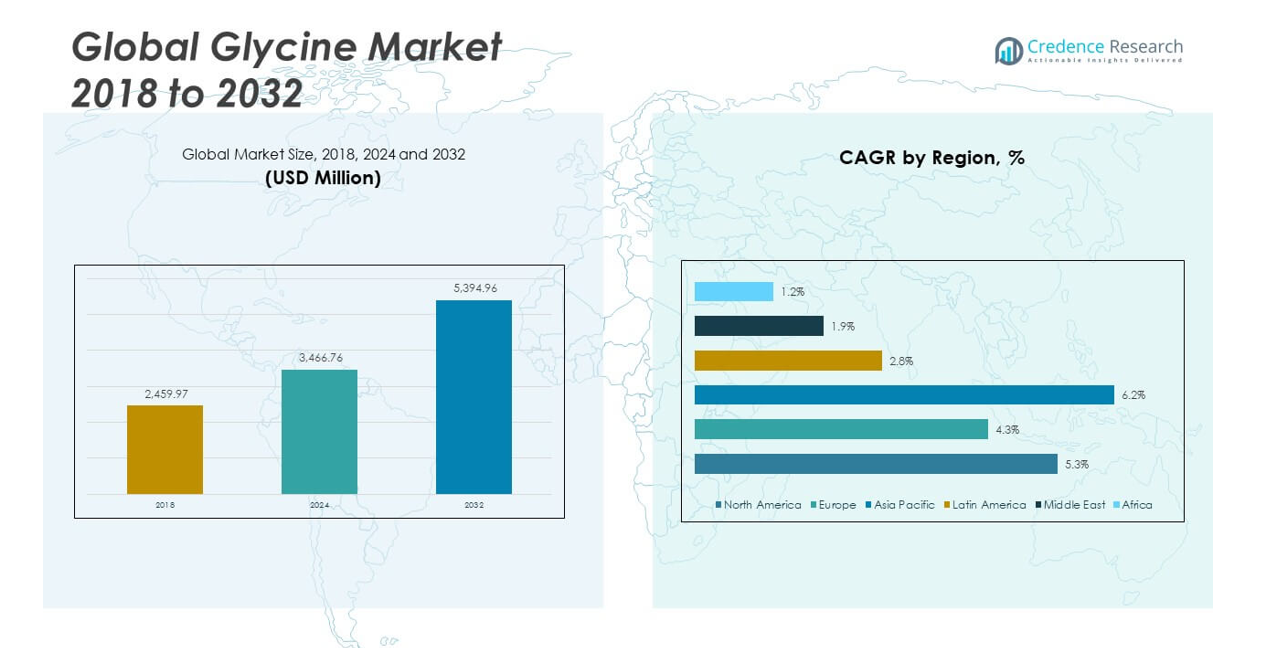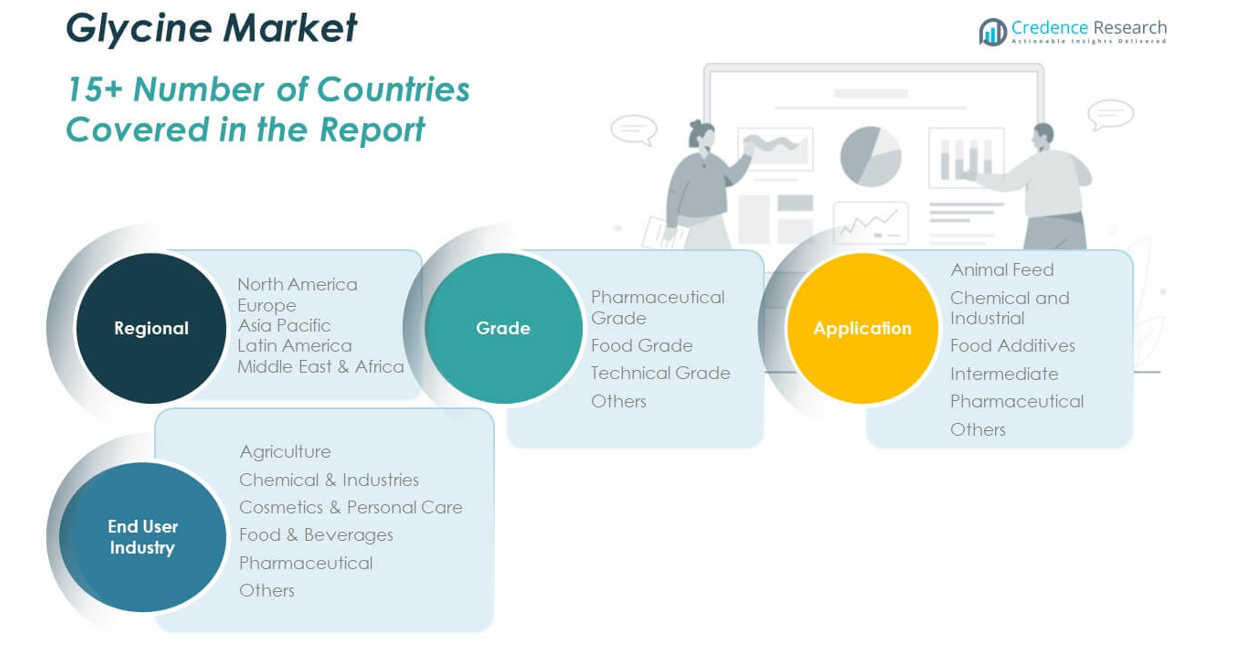CHAPTER NO. 1 : GENESIS OF THE MARKET
1.1 Market Prelude – Introduction & Scope
1.2 The Big Picture – Objectives & Vision
1.3 Strategic Edge – Unique Value Proposition
1.4 Stakeholder Compass – Key Beneficiaries
CHAPTER NO. 2 : EXECUTIVE LENS
2.1 Pulse of the Industry – Market Snapshot
2.2 Growth Arc – Revenue Projections (USD Million)
2.3. Premium Insights – Based on Primary Interviews
CHAPTER NO. 3 : GLYCINE MARKET FORCES & INDUSTRY PULSE
3.1 Foundations of Change – Market Overview
3.2 Catalysts of Expansion – Key Market Drivers
3.2.1 Momentum Boosters – Growth Triggers
3.2.2 Innovation Fuel – Disruptive Technologies
3.3 Headwinds & Crosswinds – Market Restraints
3.3.1 Regulatory Tides – Compliance Challenges
3.3.2 Economic Frictions – Inflationary Pressures
3.4 Untapped Horizons – Growth Potential & Opportunities
3.5 Strategic Navigation – Industry Frameworks
3.5.1 Market Equilibrium – Porter’s Five Forces
3.5.2 Ecosystem Dynamics – Value Chain Analysis
3.5.3 Macro Forces – PESTEL Breakdown
3.6 Price Trend Analysis
3.6.1 Regional Price Trend
3.6.2 Price Trend by product
CHAPTER NO. 4 : KEY INVESTMENT EPICENTER
4.1 Regional Goldmines – High-Growth Geographies
4.2 Product Frontiers – Lucrative Product Categories
4.3 Application Sweet Spots – Emerging Demand Segments
CHAPTER NO. 5: REVENUE TRAJECTORY & WEALTH MAPPING
5.1 Momentum Metrics – Forecast & Growth Curves
5.2 Regional Revenue Footprint – Market Share Insights
5.3 Segmental Wealth Flow – Grade & Application Revenue
CHAPTER NO. 6 : TRADE & COMMERCE ANALYSIS
6.1.Import Analysis by Region
6.1.1. Global Glycine Market Import Volume By Region
6.2.Export Analysis by Region
6.2.1. Global Glycine Market Export Volume By Region
CHAPTER NO. 7 : COMPETITION ANALYSIS
7.1.Company Market Share Analysis
7.1.1. Global Glycine Market: Company Market Share
7.1. Global Glycine Market Company Volume Market Share
7.2. Global Glycine Market Company Revenue Market Share
7.3.Strategic Developments
7.3.1.Acquisitions & Mergers
7.3.2. New Product Launch
7.3.3. Regional Expansion
7.4. Competitive Dashboard
7.5. Company Assessment Metrics, 2024
CHAPTER NO. 8 : GLYCINE MARKET – BY GRADE SEGMENT ANALYSIS
8.1.Glycine Market Overview by Grade Segment
8.1.1. Glycine Market Volume Share By Grade
8.1.2. Glycine Market Revenue Share By Grade
8.2. Pharmaceutical Grade
8.3. Food Grade
8.4. Technical Grade
8.5. Others
CHAPTER NO. 9 : GLYCINE MARKET – BY APPLICATION SEGMENT ANALYSIS
9.1.Glycine Market Overview by Application Segment
9.1.1. Glycine Market Volume Share By Application
9.1.2. Glycine Market Revenue Share By Application
9.2. Animal Feed
9.3. Chemical and Industrial
9.4. Food Additives
9.5. Intermediate
9.6. Pharmaceutical
9.7. Others
CHAPTER NO. 10 : GLYCINE MARKET – BY END USER INDUSTRY SEGMENT ANALYSIS
10.1.Glycine Market Overview by End User Industry Segment
10.1.1. Glycine Market Volume Share By End User Industry
10.1.2. Glycine Market Revenue Share By End User Industry
10.2. Agriculture
10.3. Chemical & Industries
10.4. Cosmetics & Personal Care
10.5. Food & Beverages
10.6. Pharmaceutical
10.7. Others
CHAPTER NO. 11 : GLYCINE MARKET – REGIONAL ANALYSIS
11.1.Glycine Market Overview by Region Segment
11.1.1. Global Glycine Market Volume Share By Region
11.1.2. Global Glycine Market Revenue Share By Region
11.1.3.Regions
11.1.4.Global Glycine Market Volume By Region
11.1.5.Global Glycine Market Revenue By Region
11.1.6.Grade
11.1.7.Global Glycine Market Volume By Grade
11.1.8.Global Glycine Market Revenue By Grade
11.1.9.Application
11.1.10. Global Glycine Market Volume By Application
11.1.11. Global Glycine Market Revenue By Application
11.1.12. End User Industry
11.1.13. Global Glycine Market Volume By End User Industry
11.1.14. Global Glycine Market Revenue By End User Industry
CHAPTER NO. 12 : NORTH AMERICA GLYCINE MARKET – COUNTRY ANALYSIS
12.1. North America Glycine Market Overview by Country Segment
12.1.1.North America Glycine Market Volume Share By Region
12.1.2. North America Glycine Market Revenue Share By Region
12.2.North America
12.2.1.North America Glycine Market Volume By Country
12.2.2.North America Glycine Market Revenue By Country
12.2.3.Grade
12.2.4.North America Glycine Market Volume By Grade
12.2.5.North America Glycine Market Revenue By Grade
12.2.6.Application
12.2.7.North America Glycine Market Volume By Application
12.2.8. North America Glycine Market Revenue By Application
12.2.9.End User Industry
12.2.10. North America Glycine Market Volume By End User Industry
12.2.11. North America Glycine Market Revenue By End User Industry
12.3.U.S.
12.4.Canada
12.5.Mexico
CHAPTER NO. 13 : EUROPE GLYCINE MARKET – COUNTRY ANALYSIS
13.1. Europe Glycine Market Overview by Country Segment
13.1.1. Europe Glycine Market Volume Share By Region
13.1.2. Europe Glycine Market Revenue Share By Region
13.2.Europe
13.2.1.Europe Glycine Market Volume By Country
13.2.2.Europe Glycine Market Revenue By Country
13.2.3.Grade
13.2.4.Europe Glycine Market Volume By Grade
13.2.5.Europe Glycine Market Revenue By Grade
13.2.6.Application
13.2.7. Europe Glycine Market Volume By Application
13.2.8. Europe Glycine Market Revenue By Application
13.2.9.End User Industry
13.2.10. Europe Glycine Market Volume By End User Industry
13.2.11. Europe Glycine Market Revenue By End User Industry
13.3.UK
13.4.France
13.5.Germany
13.6.Italy
13.7.Spain
13.8.Russia
13.9. Rest of Europe
CHAPTER NO. 14 : ASIA PACIFIC GLYCINE MARKET – COUNTRY ANALYSIS
14.1.Asia Pacific Glycine Market Overview by Country Segment
14.1.1.Asia Pacific Glycine Market Volume Share By Region
14.1.2.Asia Pacific Glycine Market Revenue Share By Region
14.2.Asia Pacific
14.2.1. Asia Pacific Glycine Market Volume By Country
14.2.2.Asia Pacific Glycine Market Revenue By Country
14.2.3.Grade
14.2.4.Asia Pacific Glycine Market Volume By Grade
14.2.5.Asia Pacific Glycine Market Revenue By Grade
14.2.6.Application
14.2.7.Asia Pacific Glycine Market Volume By Application
14.2.8.Asia Pacific Glycine Market Revenue By Application
14.2.9.End User Industry
14.2.10. Asia Pacific Glycine Market Volume By End User Industry
14.2.11. Asia Pacific Glycine Market Revenue By End User Industry
14.3.China
14.4.Japan
14.5.South Korea
14.6.India
14.7.Australia
14.8.Southeast Asia
14.9. Rest of Asia Pacific
CHAPTER NO. 15 : LATIN AMERICA GLYCINE MARKET – COUNTRY ANALYSIS
15.1. Latin America Glycine Market Overview by Country Segment
15.1.1.Latin America Glycine Market Volume Share By Region
15.1.2.Latin America Glycine Market Revenue Share By Region
15.2. Latin America
15.2.1. Latin America Glycine Market Volume By Country
15.2.2.Latin America Glycine Market Revenue By Country
15.2.3.Grade
15.2.4. Latin America Glycine Market Volume By Grade
15.2.5. Latin America Glycine Market Revenue By Grade
15.2.6.Application
15.2.7.Latin America Glycine Market Volume By Application
15.2.8.Latin America Glycine Market Revenue By Application
15.2.9.End User Industry
15.2.10. Latin America Glycine Market Volume By End User Industry
15.2.11. Latin America Glycine Market Revenue By End User Industry
15.3.Brazil
15.4.Argentina
15.5.Rest of Latin America
CHAPTER NO. 16 : MIDDLE EAST GLYCINE MARKET – COUNTRY ANALYSIS
16.1.Middle East Glycine Market Overview by Country Segment
16.1.1.Middle East Glycine Market Volume Share By Region
16.1.2. Middle East Glycine Market Revenue Share By Region
16.2.Middle East
16.2.1. Middle East Glycine Market Volume By Country
16.2.2.Middle East Glycine Market Revenue By Country
16.2.3.Grade
16.2.4.Middle East Glycine Market Volume By Grade
16.2.5.Middle East Glycine Market Revenue By Grade
16.2.6.Application
16.2.7.Middle East Glycine Market Volume By Application
16.2.8.Middle East Glycine Market Revenue By Application
16.2.9. End User Industry
16.2.10. Middle East Glycine Market Volume By End User Industry
16.2.11. Middle East Glycine Market Revenue By End User Industry
16.3.GCC Countries
16.4. Israel
16.5. Turkey
16.6.Rest of Middle East
CHAPTER NO. 17 : AFRICA GLYCINE MARKET – COUNTRY ANALYSIS
17.1. Africa Glycine Market Overview by Country Segment
17.1.1.Africa Glycine Market Volume Share By Region
17.1.2. Africa Glycine Market Revenue Share By Region
17.2. Africa
17.2.1.Africa Glycine Market Volume By Country
17.2.2.Africa Glycine Market Revenue By Country
17.2.3.Grade
17.2.4.Africa Glycine Market Volume By Grade
17.2.5.Africa Glycine Market Revenue By Grade
17.2.6.Application
17.2.7. Africa Glycine Market Volume By Application
17.2.8. Africa Glycine Market Revenue By Application
17.2.9.End User Industry
17.2.10. Africa Glycine Market Volume By End User Industry
17.2.11. Africa Glycine Market Revenue By End User Industry
17.3. South Africa
17.4.Egypt
17.5.Rest of Africa
CHAPTER NO. 18 : COMPANY PROFILES
18.1. Ajinomoto Co., Inc.
18.1.1.Company Overview
18.1.2.Product Portfolio
18.1.3.Financial Overview
18.1.4.Recent Developments
18.1.5.Growth Strategy
18.1.6.SWOT Analysis
18.2. Hebei Donghua Jiheng Chemical Co., Ltd.
18.3. Shijiazhuang Donghua Jinlong Chemical Co., Ltd.
18.4. Evonik Industries AG
18.5. Showa Denko K.K.
18.6. Yuki Gosei Kogyo Co., Ltd.
18.7. GEO Specialty Chemicals, Inc.
18.8. Chattem Chemicals, Inc.
18.9. Paras Intermediates Private Limited
18.10. Linxi Hongtai Chemical Co., Ltd.









